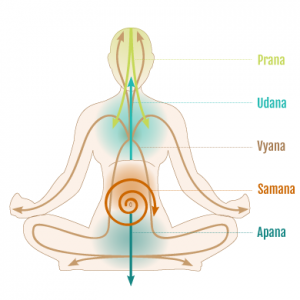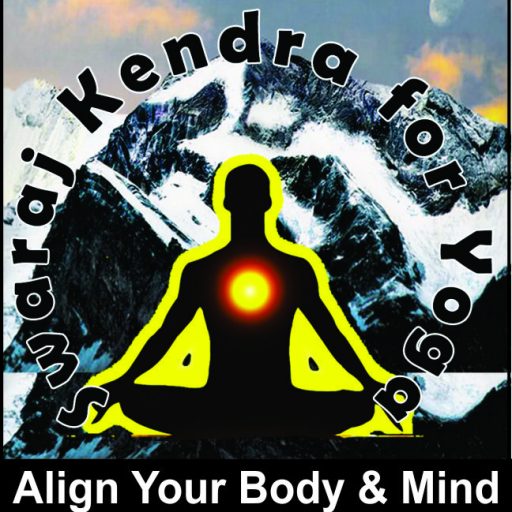Five – Prana Vayus concept of Hatha – Yoga
Prana vayus pervade all living beings and matter existing on earth and Pranic energy is the energy that moves the entire body system
Secret of the Five Prana Vayus
Vayus factually translates to wind , implying unrestricted and universal movement. So these prana vayus signify the inherent quality of motion, which energizes every action of the body from secretion of the digestive juices to the movements of the limbs. It flows through all the elements, organs and ultimately the mind.
A word of prudence 
We often experience that the yogic texts often differ in their approach and description of the five prana vayus and their respective locations too. But this should not confuse the Yoga practitioner. One should always keep in mind that the energy body is comprehended in the dominion of experience, where the boundaries are neither black nor white and are infinite and endless . The thumb rule is to continue honing’s one’s own experience and explore the unexplored horizons of mind and consciousness .
The FIVE Pranic energies
Vayus , from time to time, due to reasons, goes out of sync and leads to an imbalance not only in the physical body but also at mental and spiritual level . Regular practice of Hatha Yoga Asana and Pranayama manage the smooth balance and functioning of these Vayus. Practiced under the guidance of an expert teacher, this Pranic energy system is a highly effective alternate method of healing to keep the mind, body and spirit coordinated.
1. Prana Vayu – The Vitality Breath
Prana Vayu is residing in the heart and chest ( Yogic text also call it anahata chakra ) and is governed by the element air. This Prana vayu moves down and up from the throat centre to the navel centre .Prana vayu is not the mere energy generated only from the air we breathe but receives energy from the food stuff we eat, liquids we drink and also takes feed from all sensory perceptions and daily mental experiences.
(a) Prana Vayu is the energy that maintains Heart, Lungs, Breathing, swallowing and Blood circulation.
(b) Prana Vayu is the energy that drives the life forward and any imbalance can lead to depression, feeling low, heart and lung related ailments like bronchitis, asthma and related respiratory issues.
Warning of Prana imbalance: When the pathways of prana are not clear, the heart and lungs malfunction and there is poor intake of oxygen. At the mental level, one is not able to have positive impressions. One has to struggle to concentrate or access intuitive knowledge.
Pranayama and Yoga asana for Prana Vayu :
Bhastrika ( Bellows Breath) and it correspond to the Jalandhara Bandha (The Throat Lock).
- Parivritta Janu Shirsha asana ( Revolved head-to-knee pose) Adho Mukha Shvanasana ( Downward facing dog pose)
- Urdhva Mukha Shvanasana.(Upward-facing dog pose) Gomukha asana ( Cow’s face pose )Bridge Pose ( Setubandh Asana )
2. Apana Vayu- “the air that moves away”
The location of Apana Vayu is in the abdomen and pelvic floor (muladhara chakra ) and is governed by the element earth .
Apana Vayu moves from the navel down to the pelvic floor and governs the defecation parts i.e the ability to eject or eliminate what is not needed in your body system.
(a) Primarily governing eliminating organs like kidneys, bladder, colon, rectum and genitals, Apana Vayu is also the energy that governors the process of procreation .
(b) A Balanced Apana Vayu helps to speed up the process of pranotthana ; a perquisite for Kundalini awakening.
(c) Balance Apana Vayu balances emotions and negative thoughts.
Warnings of Apana imbalance: Apana imbalance can ultimately lead to ailments related to poor elimination system like skin psoriasis, eczema, diabetes, menstruation, infertility issues, depression,anxiety, lazy, tired, indecisive, and negativity.
Pranayama and Asana for Apana Vayu:
Kapal Bhatti also called Skull shining or Frontal Brain purifying – Forceful breath exhalations.
- Pada Prasarita Padottana asana ( Spread legged standing forward bend) Uttan Asana ( Standing Half forward bend ) Ek Pada Pranam Asana ( The tree pose) Baddha Kona asana (Bound angle pose ).Shalabh asana ( The locust pose ).Viprit Nauka asana (Reverse Boat Pose).
3. Samana Vayu. Breath of Balance
Samana Vayu is seated in the abdominal area; also called manipura chakra and is governed by the element fire . Samana Vayu moves from the periphery of the body into the core and governs the assimilation of oxygen from the air we breathe and governs the assimilation area like stomach ,Pancreas ,Spleen , Intestines ( small and large )and Liver.
(a) Samana Vayu separates nutrients from toxins in abdominal region and is the Vayu that strikes balances and stabalises both Prana and Apana Vayu.
(b) Balanced Samana Vayu helps to maintain ego, mental peace and harmony.
(c) Samana Vayu is responsible for the digestive fire.
Warnings of Samana imbalance: Samana literally means the equalizer, is always disturbed whenever we are not at mental peace and harmony . The body becomes agitated in these stress situations and cretaes disorder, whenever there is unpleasant disturbances in the body and in the five senses ( Gyan Indriya). Any imbalance here can result into health issues related to weekand sluggish digestion , IBS (Irritable Bowel Syndrome),Flatulence, Dyspepsia, Bloating, Excessive gas, Constipation, Diarrhea, Stomach and Intestinal Ulcers, Colitis, Pancreatitis, Aggression, Depression, Anxiety, excessive worrying nature , fatigue and dullness.
Pranayama and Asana for Samana Vayu:
Kapalbhati ( with medium pressure ) and Surya Bhedi also called Sun Breath ( from right nostril called Pingala nadi) and it corresponds to the Uddiyana bandha (the flying abdominal lock).
- Parivritta Parshvakona asana (Revolved side angle pose). Utkata asana ( Sitting on Chair pose ).Markat asana ( Reclining abdominal twist ).Nauka asana (Boat pose.)Marichi asana ( Abdominal Twist variations).Matsyendra asana ( The Spinal twist ) .Sitting Paschimottana asana (Sitting forward bend)
4. Udana Vayu. Breath of Ascent ( Dhayana-Meditation )
Udana Vayu is seated in the throat and the brain area; corresponds to vishuddha chakra and is governed by the element ether (sky ) . Udana Vayu is the air that which carries upwards from the throat to the head side and controls the extremities as well as all the sensory functions of our body .
Udana Vayu corresponds to the Throat (Vishudha) Chakra and medically thyroid gland area and also Third Eye ( Ajna ) Chakra medically pineal gland and balances Ether element. Udana Vayu is the energy for Meditation (Dhyana).
Jalandhara Bandha (The Chin lock) stimulates the energy and movement of Udana.
(a) Udana Vayu governs the speech , production of sound and thought expression and any imbalance can lead to health issues of ENT like tonsillitis
(b) Besides the respiratory issues Udana Vayu can also affect the nervous health and stubborn weight issues because of imbalance in Thyroid gland secretions .
Warnings of Udana imbalance: An erratic udana vayu causes breathing troubles, inefficiency in physical and mental work, restricts the ability to think clearly or express oneself, blurred speech, weakened will and dullness .
Pranayama and Asana for Udana Vayu:
Pranayama for Udana Vayu: Ujjayi (The breath of victory ).
All inversions are good for maintain healthy Udana Vayu . Sarvang asana (Shoulder stand ). Hal Asana (The Plough pose ) Matsya asana ( Fish pose ).Shirsha asana ( The Head stand ).Setu Bandha Sarvanga asana (The Bridge pose variations) Viparita Karani ( Inverted action pose like legs up to the wall ) Simh asana ( The Lion pose)
5. Vyana Vayu.(The whole body -Integrating Breath ).
Vyana Vayu the expansive energy pervades in the whole body and is the coordinating, balancing and the integrating force that binds the whole existence of us together.
In the body, Vyana vayu runs through all the 72000+ nadis (the passageways of prana) connecting all the muscles, tendons ,ligaments ,nerves, veins & joints and bringing about a sense of integrity & cohesiveness in our body .
Vyana vayu is the ‘outward moving vayu’ and plays as the outer boundary of the energy system .Vyana is associated with a sense of boundaries through which we define ourselves and interact with our world
Vyana vayu corresponds to the Navel point and Sacrum region (known as Swadisthana Chakra ) and balances Water element.
Warnings of imbalance : When Vyana vayu, the expansive energy, is unbalanced, there is lack of coordination, twitches , tremors, inability to express and reach out to people, and the mind is always erratic.
Pranayama and Asana for Vyana vayu…
Pranayama For Vyana: Anuloma Viloma. Alternate nostril breathing.
- Virabhadrasana (he Warrior poses all variations) .Ekpada parnamasana or Dhruv asana ( Tree Pose ) Chandrasana( Half moon pose). Garudasana ( Eagle pose) .All The Balancing Poses are good for this .
By Yogi Er. Anil Swaraj
The author is a certified Yoga professional by QCI and Ministry of Ayush

I so agree with this post…Really Interesting.